April itinerary in Japan Day 2 (Kochi, Ehime Meal edition)
(Tuesday, April 19)
Table of contents
1. Sakoya
I cycled from Nakamura Station on the downstream Shimanto River to Ekawasaki Station on the upstream from 8 am on April 19th (Tuesday). For breakfast, I had a rice bowl topped with grilled natural eel at “Sakoya”, which is a short distance across the Sada Chinka-bashi Bridge (Imanari Bridge). When I made a request to “eat the natural eel of the Shimanto River”, I was told “Sakoya” by the Shimanto City Tourism Association at Nakamura Station.
“Sakoya” is open from 7:00 to 14:00, so we can have a a rice bowl topped with grilled natural eel as breakfast. Locals were eating breakfast such as ham and eggs at “Sakoya”.
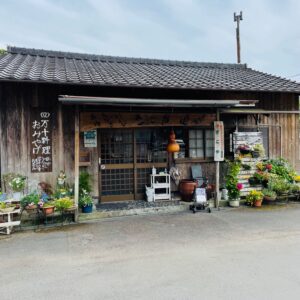
“Sakoya” goes to the Shimanto River every morning to catch natural eels, and if they cannot catch natural eels, they will provide farmed eels. Since eel fishing in the Shimanto River is limited to April 1st to September 30th, you can also eat Sakoya’s natural eels only from April to September. In the Shimanto River, river shrimp fishing can only be done from April 1st to August 31st, and sweetfish fishing can only be done from May 15th to October 15th.
Fishermen use “Longline fishing” from April to May and shift to “Korobashi fishing”. It is said that the earthworms used for “Korobashi fishing” grow to an appropriate size from May to June. Also, after midsummer, it is not possible to catch enough volume of earthworms again, and fishermen return from “Korobashi fishing” to “longline fishing”.
A longline has a structure in which a large number of branch ropes (this is called a longline) are attached to one trunk rope, and a fishing hook is attached to the tip of the branch rope. This is a fishing method in which longlines are set up in the fishing grounds in the evening, and then the longlines are collected the next morning to obtain eels.
“Korobashi” is a device for catching eels in the shape of elongated cylinders made of bamboo or wood. Fishermen set up “Korobashi” in the river in the evening and go to collect “Korobashi” the next morning.
Natural eel account for only 0.4% of the total eels caught in Japan (2020). Natural eel is very valuable.
A large amount of eels were swimming in the aquarium at “Sakoya”. I ordered the rice bowl topped with grilled natural eel (Yen 4,400). A rice bowl topped with grilled cultured eel is Yen 3,080. My biggest regret is that I was so absorbed in natural eel that I forgot to order fried river shrimp (Yen 880) .
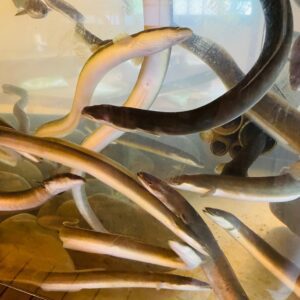
Grilled eel at “Sakoya” is a Kansai-style grilling method that is grilled without steaming. Grilled natural eel were very thick and chewy. It is completely different from cultured eel. However, since it is a natural river fish, it had a slight odor. I thought that if you value the taste, you should choose cultured eel, and if you value the chewy texture, you should choose the natural eel. Natural eel is said to be the most delicious in the summer when it gets fat. I wanted to come back someday in the summer.
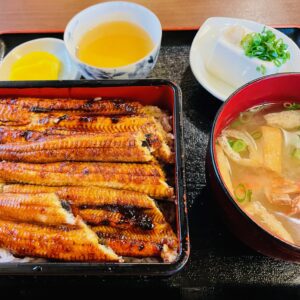
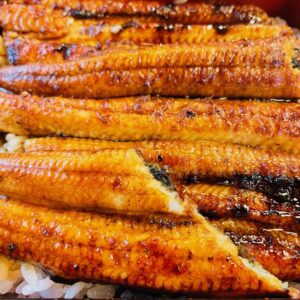
2. Yokoyama meat shop
In order to have a light lunch around Ekawasaki Station, I bought croquettes and minced meat cutlets using Shimanto beef at the “Yokoyama Meat Shop” taught by the Shimanto City Tourism Association at Nakamura Station. I ate them on the terrace while looking at the Shimanto River. Yokoyama Meat is a butcher shop, but it was like a supermarket that handles various foods.
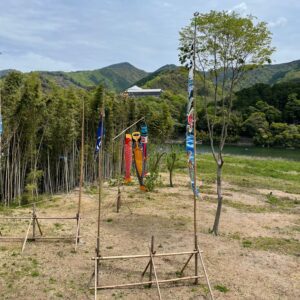
Shimanto beef is a Japanese black beef that is non-parous cow and was raised in the Shimanto River basin. It is a precious cow that is shipped only about 100 cows a year.
The croquette and minced meat cutlet were very delicious. However, it was difficult to understand the taste of Shimanto beef with croquettes and minced meat cutlets. Next time I would like to eat Shimanto beef with Yakiniku (grilled meat) or steak.
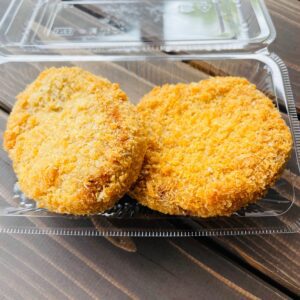
3. Local cuisine “Hozumi-tei”
My lunch was fairly light, so I entered “Hozumi-tei” at the same time as the store opened at 17:00. I had various local dishes for dinner at “Hozumi-tei”. I ordered “Sashimi platter”, “Oni Jakoten”, “Fuka no Yuzarashi”, “Hairtail bamboo roll”, “Bonito salted tataki by Fukaura port”, and “Tai (red sea bream) somen”.
The “sashimi platter” contained octopus, red sea bream, great amberjack, bonito, and halfbeak.
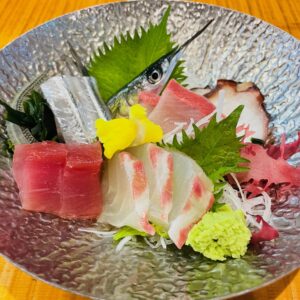
Japan Fisheries Co-operative has selected “Aiiku Fish Aidai” (season: February-May) and “Biyabiya Bonito” (season: April-June) for “PRIDE FISH” in spring in Ehime Prefecture.
“Aidai” is a farmed red sea bream that is cultivated under strict management standards in the Uwa Sea (Uwajima), which is a rich fishing ground where the ria coast and the Kuroshio (black current). Ehime Prefecture has the 4th largest catch of natural red sea bream in Japan (1st is Fukuoka Prefecture), but the catch share of cultured red sea bream is 47%, which is overwhelmingly 1st (2nd is Kumamoto Prefecture with 12% share). The Ehime prefecture has a catch share of 56%, which is the sum of natural red sea bream and cultured red sea bream. Even at “Hozumi-tei”, it was a delicious red sea bream with a crunchy feeling and sweetness.
“Biyabiya bonito” is a fresh bonito caught at Fukaura fishing port. “Biyabiya” is a dialect of Ainan Town where the Fukaura fishing port is located, and means “very fresh and elastic”. “Biyabiya bonito” is drained blood from a live fish on board immediately after fishing. Also, to maximize the freshness, fishermen land the fish the same day they catch it. The bonito sashimi and salted tataki I ate at “Hozumi-tei” were also very delicious.

Bonito tataki is cooked with straw in front of the counter at “Hozumi-tei”. Straw contains a small amount of oil, so when it is burned, the firepower becomes stronger. Since the heating time is short due to the strong heat, it is suitable for tataki where only the outside is quickly blown and the inside remains rare. The good scent of straw is transferred to the bonito, and a delicious bonito tataki is completed.
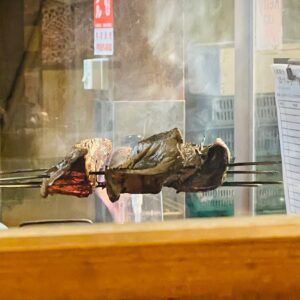
Kochi Prefecture is famous for bonito, but Kochi Prefecture has the fourth largest bonito catch in Japan (2020). Fukaura fishing port in Ehime prefecture has the highest bonito catching port in Shikoku. However, the total catch of bonito in Ehime prefecture is 16th in Japan.
“Oni Jakoten” is a thick “Jakoten”. “Uwajima fish paste studio Miyoshi” produces “Oni Jakoten”. “Jakoten” has been selected as a local dish of Ehime prefecture from “100 selections of local dishes” by the Ministry of Agriculture, Forestry and Fisheries. “Jakoten” is a dish from the Nanyo region such as Uwajima City. It is said that the name “Jakoten” comes from the mixed small fish (Zako) used as a raw material. The wife of the owner at “Hozumi-tei” recommended that “Jakoten” is thin these days, but “Oni Jakoten” is thick and delicious, so please try it. The “Kureten” I ate at Tosa Kure the day before was delicious, but the “Oni Jakoten” was also very delicious and impressed.

“Fuka no Yuzarashi” is introduced by the Ministry of Agriculture, Forestry and Fisheries as “Our Regional Cuisines” in Ehime prefecture. “Fuka” is a shark. Sharks around 1 meter are often caught in Nanyo. People in Nanyo eat “Fuka” with vinegar miso, because “Fuka” has a light taste. I felt a little watery, and I couldn’t get the impression of other local dishes I ate at “Hozumi-tei” from “Fuka no Yuzarashi”.

“Hairtail bamboo roll” is introduced by the Ministry of Agriculture, Forestry and Fisheries as “Our Regional Cuisines” in Ehime prefecture. “Kawai Tachiuomaki” invented “Hairtail bamboo roll” in 1987 in Yoshida Town, Uwajima City. The “Hairtail bamboo roll” of “Hozumi-tei” is wrapped tightly around the bamboo, so I felt it was a little hard. Someday I would like to eat freshly baked at “Kawai Tachiuomaki”.

The last “Tai (red sea bream) somen” I ate was very delicious. “Tai somen” is a small-sized red sea bream that is boiled in its entirety and served on a platter with somen noodles. In the Nanyo region, it is eaten with garnish such as thin omelette cut into strips and shredded shiitake mushrooms. It seems that five-colored somen noodles are often used in the Matsuyama area. In Uwajima City, it is customary to eat “Tai somen” along with “Fukumen” at a celebration. I ate “Fukumen” at lunch the next day, so I will explain it in the BLOG four days later. “Tai somen” is also introduced by the Ministry of Agriculture, Forestry and Fisheries as “Our Regional Cuisines” in Ehime prefecture.

I was very happy to eat many local dishes at “Hozumitei”. I liked it very much and had lunch at “Hozumitei” the next day. It has been selected as one of the 100 famous restaurants in Tabelog.

I had a very satisfying dinner at “Hozumitei” and went for a walk to help my digestion at “Kisaiya Road” in the Uwajima shopping district. Like the shopping streets of many local cities, there was little traffic. Many “Ushi-Oni (cow demon)” masks were displayed on “Kisaiya Road”. A mask of “Ushi-Oni” is used for the “Uwajima Ushi-Oni Matsuri (festival)” held in July every year.
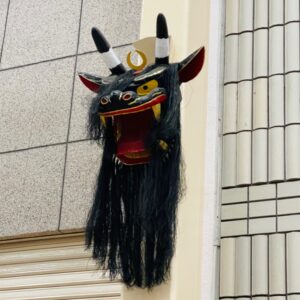
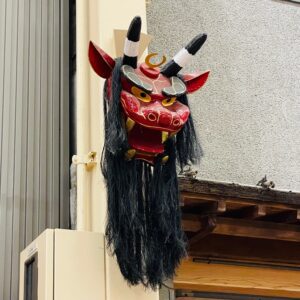
Note: The departure / arrival times, fares of transportation, admission fees, meal fees, etc. listed in the text are as of the time of writing the BLOG. Please check for yourself when you go on a trip as it may change in the future.